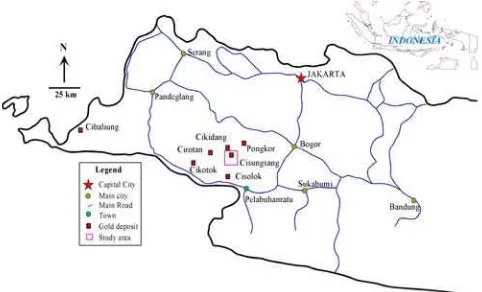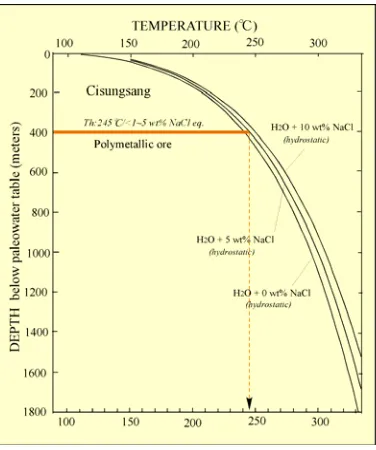The Occurrences of Base Metal Mineralization in Cikadu-Cisungsang
Area, Banten Province, Indonesia*)
Rosana, M.F., Haryanto, A.D., Yuniardi, Y., Yuningsih, E.T.
Department of Geology, Padjadjaran University
Jl. Raya Bandung Sumedang Km 21, Jatinangor, Sumedang 45363 rosanamf@yahoo.com; rosanamf@melsa.net.id
Abstract
The Cikadu-Cisungsang area is located in the Bayah gold district, Banten Province of Western Java. The base metal mineralization occurred in the limestone host rocks of Miocene age. The ore is occurring as banded and quartz vein within the limestone. The mineralized body is identified as hydrothermal breccias, banded sulfide-quartz and silicified limestone. The ore minerals consist of sphalerite, galena, arsenopyrite, pyrite, marcasite, silver minerals, chalcopyrite, and pyrrhotite. those are occur as hydrothermal breccias. Silver minerals of aguilarite, pyrargyrite, proustite, and canfildite occur as fine to very fine grained crystals in galena. Metal contents are mostly of Pb (~130,000 ppm), Zn (~2,9800 ppm), As (~7,300 ppm), Cu (~94 ppm), Sb (~151 ppm), Ag (~303 ppm), and Au (~1.88 ppm). The gangue minerals mostly are silica and small amount of calcite, and rarely clay minerals. The silica varies from fine to coarse-grained of quartz to chalcedony. Homogenization temperatures obtained from fluid inclusion in quartz are ranging from 240°C to 300°C, while the salinities are from 2.2 to 3.4 wt% NaCl eqv. Considering the mode of occurrence of ore and host rocks and the formation temperatures and depth the Cikadu-Cisungsang mineralized body might be formed in the mesothermal environment The present of canfildite mineral, which is uncommon in typical epithermal deposits, probably due to the reworking of older continent crust as the source of metal or magmatic activities, in which several dacitic lavas and intusions of similar ages are observed within the area. Further studies should be done with special attention from view point of island arc geologic and tectonic setting to clarify the time-spatial relationship of the base metal and gold mineralization in the Bayah district.
INTRODUCTION
The Cikadu-Cisungsang area is located southeast of Cikidang gold mine, Banten
Province of Western Java (Fig.1). The tectonic setting of Western Java is influenced by
subduction of the Indian-Australian Plate under the Eurasian continent. The gold ores of
Western Java are an integral part of the geology of Western Java. Its major metallogenic
event during the Miocene and the Pliocene are located in the Bayah Dome, a
Tertiary-Quaternary volcanic structure at west end of Java, which is well known as gold
district, where the Cirotan, Cikidang, Cikotok, and Pongkor gold mines are located. There
are two noticeably different styles of epithermal gold deposits within the Bayah dome, both
are gold bearing quartz veins; they are known as “Cirotan type” and “Pongkor type”. The
Cirotan type (1.7 Ma, Marcoux and Milesi, 1994) is characterized by abundant sulfide
minerals and its cockade texture, where as the Pongkor type (2.05 Ma, Milesi et al, 1999) is
characterized by very low sulfide content, occurrence of adularia, calcite and manganese
oxide.
The base metal mineralizations well observe in the Cisungsang and Bojong area (Rosana
a base metal bearing quartz vein which trending for about N800E and dipping about 750 to
the south. Hydrothermal alteration is not well developing in the area, as mostly dominated
by silicic alteration and locally argillic alteration. The mineralized body has some
similarities in ore mineral compositions with the Cirotan type (Rosana and Matsueda, 2002).
Fig. 1. Location of the Cisungsang area and other major gold deposits in Western Java
METHODS
The research is aimed to study the characteristics of the ore body and its distribution
both lateral and vertical, and to know the economic potential of the ore. Detail geological
and alteration mapping were applied to identified the geology of the area and the distribution
of altered rocks and associated mineralized ore body. Samples were collected from outcrops
of mineralized body and analyses were done for mineral identification by Petrography,
mineragraphy and XRD analyses to identify the rock type and metal mineral contents and
alteration minerals.; the minerals chemistry were analyzed by electron probe microanalysis
(EPMA), AAS, ICP-MS and LA-ICP-MS; fluid inclusions thermometric analysis were
done by Linkam using the criteria of Roedder (1984).
RESULTS
The mineralized ore body, both in Cisungsang and Bojong area are cropped out in the
limestone of the Cimapag Formation of Miocene age. The ore is occurring as banded
sulfide-quartz minerals vein within the limestone. The mineralized body is identified as
specimen can be differentiated clearly. The silicified limestone stages is characterized by
gray color of limestone which replace by silica and small quartz veinlet, rarely disseminated
pyrite which replaced foraminifera fossil and calcite. This is representing the altered
limestone host rocks The banded sulfide-quartz stage is characterized by thin banding of
pyrite-arsenopyrite-marcasite, galena, sphalerite, chalcopyrite and quartz. This stage is
characterized by it yellow to gray color of metal. The hydrothermal breccia comprising of
fragmen banded sulfide-quartz ore, silicified limestone, altered pumice and pyroclastic tuff
in chalcedonic to fine quartz matrix. Its shos dark brown to yellowish brown color and
become more yellowish if dominated by prite-arsenopyrite and chalcopyrite minerals.
The ore minerals consist of sphalerite, galena, arsenopyrite, pyrite, marcasite, silver
minerals, chalcopyrite, and pyrrhotite. those are occur as banded sulfide-quartz and
hydrothermal breccias. Silver minerals of aguilarite, pyrargyrite, proustite, and canfildite
occur as fine to very fine grained crystals in galena (Rosana, 2004). It has not been observed
in pyrite, arsenopyrite, chalcopyrite, or sphalerite. At present there has not been found any
gold or electrums observe under the microscope. Metal contents are mostly of Pb
(~130,000 ppm), Zn (~2,9800 ppm), As (~7,300 ppm), Cu (~94 ppm), Sb (~151 ppm), Ag
(~303 ppm), and Au (~1.88 ppm). The gangue minerals mostly are silica and small amount
of calcite, and rarely clay minerals. The silica varies from fine to coarse-grained of quartz to
chalcedony. The chemical composition of the sphalerite indicating high content of iron,
which is vary from 13.6 to 19.6 mol % FeS. The arsenopyrite exhibit extreme chemical
variation in As and S, ranging from 24 to 33 mol % As (Rosana and Matsueda, 2002).
The fluid inclusions are vary from 10-200μm, aqueous and two-phase; liquid and vapor,
they comprise primary and secondary inclusions, either in quartz and calcite
Homogenization temperatures obtained from fluid inclusion in quartz are ranging from
240°C to 300°C, while the salinities are from 2.2 to 3.4 wt% NaCl eqv.
DISSCUSSIONS
The Cisungsang and Bojong mineralized body occurs as banded sulfide-quartz vein. It
crop out in form of hydrothermal breccia in the upper part in the limestone host rock of
Cimapag Formation. The mineral assemblages are dominated by sulfide minerals of iron
its mineral assemblage make it different type of mineralization in compared to the Cikidang
deposit, which is only about 4 km apart (Rosana & Matsueda, 2002).
The micrometric results of fluid inclusions either from calcite and quartz hosted fluid
inclusions indicated a homogenization temperature of ore zone is from 240°C to 300°C with
low salinity of less than 4 wt% NaCl eqv. Applying method of Haas, 1971, the depth of ore
deposition may be estimated. However, as the boiling phenomena was not observed
uncertainty in the fluid inclusions, the temperature of boiling is assuming based on the
temperature of fluid inclusions from the maximum high content of ore minerals assemblage
(polymetallic stage), which shows wide range temperature. The depth of about 400 m of ore
deposition is suggested, if the boiling is occurred at about 240℃, up to about 1000 m if
boiling happen at 300℃ (Fig.2). It suggested that the ore deposition in the Cisungsang and
Bojong ore are at shallow mesothermal about 240 to 300℃ of low sulfidation base metal
systems, which characterized by it low grade gold, pyrite is dominant sulfide, with
Pb>Zn>Cu, quartz gangue is dominated over carbonate, and increasing of Fe-content of
sphalerite is correlated with increase in temperature.
Considering the mode of occurrence of ore and host rocks and the formation temperatures
and depth the Cikadu-Cisungsang mineralized body might be formed in the mesothermal
environment The present of canfildite mineral, which is uncommon in typical epithermal
deposits, probably due to the reworking of older continent crust as the source of metal or
magmatic activities, in which several dacitic lavas and intusions of similar ages are observed
within the area. Further studies should be done with special attention from view point of
island arc geologic and tectonic setting to clarify the time-spatial relationship of the base
metal and gold mineralization in the Bayah district.
REFERENCES
Haas, J.L., 1971. The effect of salinity on the maximum thermal gradient of a hydrothermal
system at hydrostatic pressure. Econ. Geol. 66,940-946.
Marcoux, E. and Milesi, J. P., 1994. Epithermal gold deposit in West Java, Indonesia:
geology, age and crustal source. J. Geochem. Expl. 50: 393-408.
Milesi, J. P., Marcoux, E., Sitorus, T., Simandjuntak, M., Leroy, J. and Baily, L. ,1999.
Pongkor (West Java, Indonesia): A Pliocene supergene-enriched epithermal Au-Ag-
(Mn) deposit. Mineral. Deposita , 34, 131-149.
Roedder, E. (1984) Fluid Inclusions. Reviews in Mineralogy, Mineral Soc.Amer., v.12,
646p.
Rosana, M.F., and Matsueda, H., 2002. First observation of the base metal mineralization in
the Cikidang gold mining area, Western Java, Indonesia. Resource Geol. Ann. Meet. 52,
p03.
Rosana, M.F., 2004. Genesis and formation environments of the hydrothermal gold
mineralization in the island arc geology of western Java, Indonesia. Hokkaido
University, Japan. Unpublish dissertation.
Sujatmiko and Santosa, S. (1992) Geology of the Leuwidamar Quadrangle, Java. GRDC,
Bandung, Indonesia.
Van Bemmelen, R.W., 1949. The geology of Indonesia. Vol IA. Govt. Printing Office, The

